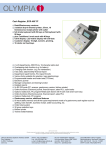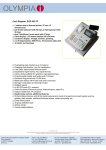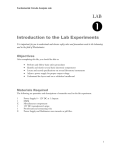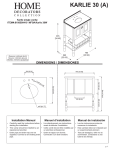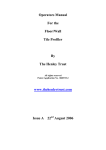Download User guide to assessed occupations — 2014-15
Transcript
User guide to assessed occupations ― 2014-15 This list provides a guide to the occupations assessed by the Department of Employment as part of its skill shortage research in 2014-15. It combines the results of research undertaken at the national and the state and territory levels to provide information about the labour market for skilled occupations at the national level. Ratings may, however, vary across the states and territories. Where an occupation is rated as being in shortage, the Department considers that shortages are widespread enough to be considered national, although they may not be apparent in every location. State and Territory Skill Shortage Lists are published at http://docs.employment.gov.au/node/31447. Reports analysing specific labour markets are accessible by clicking on the occupation titles. Only occupations assessed by the Department in 2014-15 are listed, and shortages may be evident in some labour markets for which an assessment has not been made. See the Technical notes for definitions. Occupations marked with * have not been assessed continuously over the five years. Occupation Accountants 2211 Accountants Agriculture and Horticulture Occupations 2341-11,12 Agricultural Consultant/Scientist 3622-12 Arborist Automotive Trades 3211-11 Automotive Electrician 3212 (part) Motor Mechanics 3241-11 Panelbeater 3243-11 Vehicle Painter Building Professions 1331-11 Construction Project Manager 2321-11 Architect 2322-12 Surveyor 2326-11 Urban and Regional Planner Quantity Surveyor* 2332-13 Building Technicians 3121-11 Architectural Draftsperson 3121-12 Building Associate 3121-14 Construction Estimator Number of years in shortage, five years to 2014-15 National Rating No shortage 0 No shortage Shortage 2 5 Shortage Shortage Shortage No shortage 5 5 5 3 No shortage No shortage Shortage No shortage Shortage 1 0 4 0 3* No shortage No shortage Recruitment difficulty 0 0 2 for positions in residential construction requiring five to 10 years experience Child Care Occupations 1341-11 Child Care Centre Manager 4211-11 Child Care Worker Shortage No shortage 3 4 Department of Employment Skill Shortage Research, 2014-15 Number of years in shortage, five years to 2014-15 Occupation National Rating Construction Trades 3311-11 Bricklayer 3311-12 Stonemason 3312 Carpenters and Joiners 3322-11 Painting Trades Worker 3331-11 Glazier 3332-11 Fibrous Plasterer 3332-12 Solid Plasterer 3333-11 Roof Tiler 3334-11 Wall and Floor Tiler 3341 Plumbers Shortage Shortage No shortage No shortage Regional shortage No shortage Shortage Shortage Shortage Recruitment difficulty 2 4 0 0 1 0 2 5 1 2 for roof plumbers 3941-11 Cabinetmaker Electrotechnology and Telecommunications Trades 3411-11 Electrician (General) 3421-11 Airconditioning and Refrigeration Mechanic 3422-11 Electrical Linesworker 3423-14,15 Electronic Instrument Trades Worker 3424 Telecommunications Trades Workers* Engineering Professions and Technicians 2332 (part) Civil Engineering Professionals (excluding Quantity Surveyor) 2333-11 Electrical Engineer 2335-12 Mechanical Engineer 2336 Mining Engineer 3122 Civil Engineering Draftspersons and Technicians Engineering Trades 3222-11 Sheetmetal Trades Worker 3223-11 Metal Fabricator 3223-13 Welder (First Class) 3231 Aircraft Maintenance Engineers 3232 (part) Fitters 3232-14 Metal Machinist (First Class) Food Trades 3511-11 Baker 3511-12 Pastrycook Shortage 2 No shortage No shortage 1 4 Regional shortage No shortage No shortage 3 2* 0* No shortage 2 No shortage No shortage No shortage No shortage 2 2 3 2 Shortage No shortage No shortage No shortage No shortage Shortage 5 1 0 1 1 4 Shortage Recruitment difficulty 5 3 for à la carte restaurants 3512-11 Butcher or Smallgoods Maker 3513-11 Chef Hairdressers 3911-11 Hairdresser Regional shortage No shortage 4 4 Shortage 4 Department of Employment Skill Shortage Research, 2014-15 Number of years in shortage, five years to 2014-15 Occupation National Rating Health Professions 2346-11 Medical Laboratory Scientist 2512-11 Medical Diagnostic Radiographer No shortage Recruitment difficulty 0 0 for radiographers in some locations where training is not available 2512-12 2512-14 2514-11 2515-11,13 2523-12 2524-11 2525-11 Medical Radiation Therapist Sonographer Optometrist Hospital and Retail Pharmacist Dentist Occupational Therapist Physiotherapist No shortage Shortage Shortage No shortage No shortage No shortage Recruitment difficulty for 0 5 4 0 0 0 3 positions in aged and disability care and in smaller states and territories Podiatrist 2526-11 2527-11 Audiologist* 2527-12 Speech Pathologist Nurses 2541-11 Midwife 2544 Registered Nurses 4114-11 Enrolled Nurse Resources Related Occupations 2336 Mining Engineers 2344 Geologists and Geophysicists School Teachers 2411-11 Early Childhood (Pre-primary School) Teacher 2412-13 Primary School Teacher 2414-11 Secondary School Teacher 2415 Special Education Teachers Other Occupations 2713-11 Solicitor* No Shortage Shortage No shortage 1 2* 1 Shortage No shortage No shortage 4 2 3 No shortage No shortage 3 3 No shortage 2 No shortage No shortage No shortage 0 0 0 No shortage 0* Department of Employment Skill Shortage Research, 2014-15 TECHNICAL NOTES Ratings in this report reflect discussions with a large number of employers and recruitment agents and it is important to note that employers’ recruitment experiences can vary widely, even within an individual occupation in similar locations. The Department assigns skill shortage ratings to occupations based on the results of SERA, as well as consideration of a range of labour market indicators. A rating of ‘shortage’ does not necessarily indicate that every applicant will readily gain employment and a rating of ‘no shortage’ does not suggest that good applicants will experience difficulty gaining employment. Employers’ requirements can be highly specific and candidates for positions may be regarded as unsuitable even if they hold relevant, formal qualifications. In addition, advertised vacancies can remain unfilled despite attracting suitable applicants as applicants may not take up offers of employment for a variety of reasons. Occupations are assigned the following ratings: Shortage: Skill shortages exist when employers are unable to fill or have considerable difficulty filling vacancies for an occupation, at current levels of remuneration and conditions of employment, and reasonably accessible location. Recruitment Difficulty: Recruitment difficulties occur when some employers have difficulty filling vacancies for an occupation. There may be an adequate overall supply of skilled workers but some employers are unable to attract and recruit sufficient, suitable workers for reasons which include specific experience or specialist skill requirements of the vacancy; differences in hours of work required by the employer and those sought by applicants; or transport issues. No Shortage: Research has not identified widespread significant difficulty filling vacancies. This does not mean individual employers in some locations or those seeking specialised skills will readily fill their vacancies. Details of the Department’s Skill Shortage Research methodology are published at http://docs.employment.gov.au/node/34245 Department of Employment Skill Shortage Research, 2014-15





